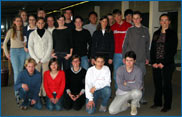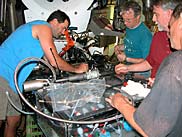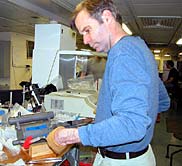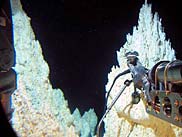|
|
|||||||||||||||||||||||||||||||||||||||||||||||||||||||||||||||||||||||||||||||||||||||||||||||||||
 |
|||||||||||||||||||||||||||||||||||||||||||||||||||||||||||||||||||||||||||||||||||||||||||||||||||
We are on our way to Bermuda now, and have a little time to think about what we have done and what will come next. The objective for fluid chemists on this expedition was to characterize the full range of fluids that are venting at the Lost City field in order to understand the processes that form the fluids. We intend to use the fluid composition to understand the conditions of water-rock reaction between the peridotite/gabbro host rock and circulating seawater, the reactions that occur during formation of the carbonate chimneys, and the sources of chemical energy for microbes living within and on the vent formations. Our main activity during the expedition was to find and sample fluids wherever we could, generally using geologic exploration dives to find sampling targets and take samples of opportunity with the titanium major and gas-tight bottles, then following up with intensive water sampling dives using the Hydrothermal Fluid and Particle Sampler, commonly known as the Beast. We took a total of 37 titanium major samples and 40 fluid samples (in Tedlar bags or pvc pistons) with the Beast. This stage in the study of the chemistry of serpentinization fluids in the ocean is analogous to the study of mid-ocean ridge volcanic hydrothermal systems in 1977, when the Galapagos vents were discovered.
We know we have something new and important, we suspect that it is wide-spread, and we don’t know how important it is quantitatively for the balance of ocean chemistry and the alteration of ocean crust. Lost City is the first and only known example of a vent field driven by serpentinization, the chemical process that occurs when mantle rocks are exposed to seawater. We have tried to sample as much of the field as possible so that chemical analysis in our laboratories on shore will tell us how this system works and how it affects ocean chemistry. The tectonic environment near the Atlantis fracture zone makes Lost City unlike any known volcanic hydrothermal system. One of the most exciting features of Lost City is that we have access to the ocean crustal section directly beneath the active vent field. Tectonic forces have literally stretched and ripped the crust apart at Lost City, and by diving and exploring the near-vertical wall on the edge of the field, we can look at the underlying plumbing that feeds the vent field. For those of us who have been looking only at the upper surface of hydrothermal systems, this is a fantastic prospect.
Throughout the proposal process and planning stage for this expedition, we have been thinking about sampling fluids coming directly out of the host peridotite, potentially giving us access to “reaction zone” fluids that have not been affected by transport through the massive carbonate structures, which are more than 50 meters thick in the vent field. Sampling fluids beneath the carbonates and on top of the carbonates has the potential to tell us what reactions take place in the peridotite-seawater zone and how these fluids change as they form the carbonate deposits. However, there is a dilemma. Wherever there is active flow of serpentinization fluids, there are large carbonate structures. Even on the near-vertical wall, 20-40 m tall carbonate chimneys grow. Virtually all cracks in the peridotite/gabbro host rock are filled with carbonate. So, even though we have a fantastic exposure to the plumbing system beneath the vent field, we do not have direct access to unadulterated fluids created by the reaction of seawater with peridotite.
When this putative pure source fluid meets seawater, the result is carbonate formation. This results in filling fractures with carbonate and forming massive deposits where fluids leak out on the seafloor. While this may be a disappointment to fluid chemists who had hoped that nature would supply a fountain of pure source fluids, it is certainly not a cause for despair in what chemistry can tell us about how this system operates. The fluids may not appear as immediately revealing as we imagined (the full picture will only become clear after detailed laboratory analysis on shore), but we still have a remarkably full picture of the system, because the chemical story is contained in both the fluids and solids, and we are analyzing the whole spectrum: fluids, peridotites, gabbros, and carbonates. In particular, analysis of the fluids and carbonates will reveal what is transported out of the system in the venting fluids and what is locked up, at least temporarily, in the carbonate deposits. Detailed studies of what happens to the carbonates as they age will help us understand the history of the deposits and their overall impact on the chemistry of the ocean and oceanic crust. Our shipboard work on the fluids tells us that there is not a great deal of variation in the major element chemistry (e.g. the calcium concentration of the source fluids), and that all fluids have pH higher than seawater, but there is a relatively large variation in the reactive compounds that are commonly involved in biological productivity (e.g. hydrogen sulfide, hydrogen, and methane). Detailed trace element and isotopic analysis of fluids and rocks should give us a much clearer picture of how this system operates, and we are eager to get the samples back to the lab and start working on them. |
|||||||||||||||||||||||||||||||||||||||||||||||||||||||||||||||||||||||||||||||||||||||||||||||||||




